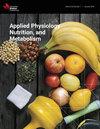Options for substantiating protein content claims for conventional foods
IF 2
4区 医学
Q3 NUTRITION & DIETETICS
引用次数: 0
Abstract
Applied Physiology, Nutrition, and Metabolism, Ahead of Print.In Canada and the United States, front-of-package protein content claims require data to support the quality of the protein. In general, protein quality reflects the product of the amino acid composition of the food protein relative to human amino acid requirements and a measure of digestibility. The currently accepted method in both jurisdictions is the protein digestibility-corrected amino acid score (PDCAAS) that requires the measurement of true fecal protein (nitrogen) digestibility. The latter must be measured in vivo using a rat model. This requirement for animal testing is inconsistent with international efforts to reduce the usage of animals in testing for regulatory purposes. The current commentary positions four options to remove the need to use animal testing for determining protein quality, when considering protein content claim substantiation. These options include (i) a focus on protein quantity alone; (ii) the use of the amino acid score alone, with no correction for digestibility; (iii) the use of a fixed digestibility coefficient to estimate protein quality; and (iv) the use of in vitro methods to measure protein and/or amino acid digestibility. The relative merits and deficiencies of the options are positioned with the goal of encouraging dialogue within the regulatory agencies to move towards alternative approaches for substantiating protein content claims on foods, including those derived from plant-based sources.
证实传统食品蛋白质含量声明的备选方案
应用生理学、营养学和新陈代谢》(Applied Physiology, Nutrition, and Metabolism, Ahead of Print)。 在加拿大和美国,包装正面的蛋白质含量声明要求有数据支持蛋白质的质量。一般来说,蛋白质质量反映的是食品蛋白质的氨基酸组成与人体氨基酸需求量的乘积,以及消化率的衡量标准。目前两个司法管辖区公认的方法是蛋白质消化率校正氨基酸评分法(PDCAAS),它要求对粪便中真正的蛋白质(氮)消化率进行测量。后者必须使用大鼠模型进行体内测量。这一动物试验要求与国际上为减少监管试验中的动物使用所做的努力不一致。目前的评注提出了四种方案,以便在考虑蛋白质含量声明的真实性时,不再需要使用动物试验来确定蛋白质的质量。这些方案包括:(i) 仅关注蛋白质数量;(ii) 仅使用氨基酸评分,不对消化率进行校正;(iii) 使用固定的消化率系数来估计蛋白质质量;(iv) 使用体外方法来测量蛋白质和/或氨基酸的消化率。对这些方案的相对优点和不足进行了定位,目的是鼓励监管机构内部开展对话,以便采用其他方法来证实食品(包括从植物中提取的食品)的蛋白质含量声明。
本文章由计算机程序翻译,如有差异,请以英文原文为准。
求助全文
约1分钟内获得全文
求助全文
来源期刊
CiteScore
6.50
自引率
2.90%
发文量
113
审稿时长
4-8 weeks
期刊介绍:
Applied Physiology, Nutrition, and Metabolism publishes original research articles, reviews, and commentaries, focussing on the application of physiology, nutrition, and metabolism to the study of human health, physical activity, and fitness. The published research, reviews, and symposia will be of interest to exercise physiologists, physical fitness and exercise rehabilitation specialists, public health and health care professionals, as well as basic and applied physiologists, nutritionists, and biochemists.

 求助内容:
求助内容: 应助结果提醒方式:
应助结果提醒方式:


